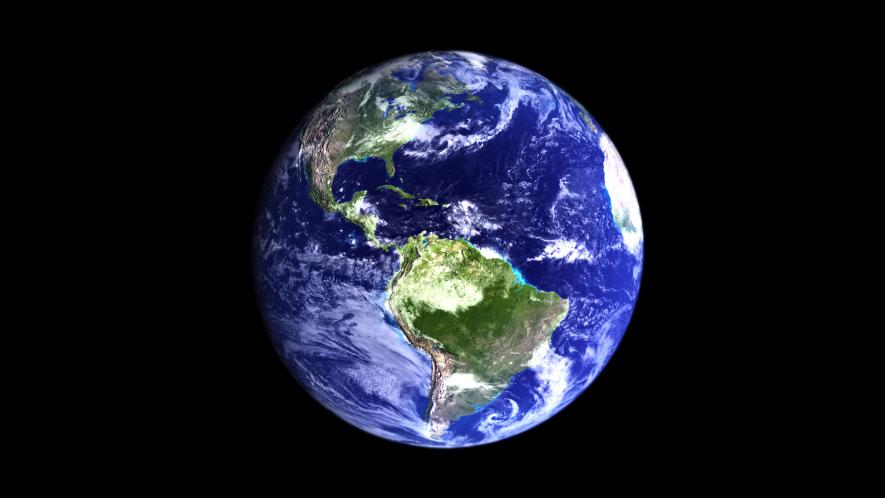What Makes Oxygen Abundant on Earth? May be Linked to Speed of Earth’s Rotation

Oxygen is a remarkable component of Earth’s air, it is the component that fuels life on Earth. The abundance of oxygen on Earth has not always been the same. Once, this gas was scarce. About three million years ago, oxygen in the atmosphere and in oceans, was scarce. So, how did oxygen become abundant on earth? This question has intrigued scientists for long, and they are still struggling to find a satisfactory explanation.
Recently, a research team proposed something new while trying to explain how oxygen became an abundant component in Earth’s air. Their hypothesis is that there may be a link between how fast Earth spins on its axis and the production of excess oxygen in ancient times. The speed of rotation determines the length of a day.
The team of researchers modelled early days of Earth and in it they incorporated evidence from microbial mats that coated the bottom of a shallow, sunlit sinkhole in the lake Huron, in North America. The team came out with an intriguing conclusion, that is, as the spin of Earth gradually decreased and the days became longer, it triggered more photosynthesis from the similar microbial mats, resulting in building up of oxygen in ancient seas which eventually diffused into the atmosphere.
The new hypothesis was published in Nature Geoscience on August 2, and has been received with excitement by some scientists. Woodward Fischer, a geo biologist at the California Institute of Technology, who was not involved in the study, was quoted to have commented in a statement that “the rise of oxygen [on Earth] is easily the most substantial environmental change in the history of our planet. The study offers a totally new flavour of an idea. It’s making a connection that people haven’t made before.”
Life appeared on Earth about some four billion years ago. The only living creatures that time were single-celled and were present in the vast and shallow seas. Many of these earliest life forms were the cyanobacteria which can form mats (thin films) on sediments and also on rock surfaces. The cyanobacteria are present today, too, and these sometimes cause algal blooms, a deadly phenomenon for fish and other aquatic animals.
Cyanobacteria evolved earliest to do photosynthesis and could convert carbon dioxide and water into oxygen and sugar. It has been thought for long that these microbes that are able to do photosynthesis were the earliest suppliers of oxygen on for over eons, which ultimately created an environment favourable for the aerobic life forms. But there remains a puzzle among scientists -- why did it take a billion years between the emergence of first photosynthetic microbes (fossils indicate it as 3.5 billion years ago) and the first evidence of build-up of oxygen.
It was known to scientists that early Earth used to rotate much faster on its axis than what it does now. It has been estimated that about 4.5 billion years ago, the Earth’s rotation on its axis was so fast that a day was only six hours long. Estimations of this sort come from modelling studies involving the Moon’s distance from Earth and the atmospheric and oceanic tides.
But, about 2.4 billion years ago, the Earth’s rotation slowed down and days got longer, with about 21 hours in a day. Again, the rotational speed slowed and about 700 million years ago the Earth attained the speed as it does today and it has been stable since then with a day having 24 hours.
The team of researchers that proposed the new hypothesis, led by Judith Klatt, a biogeochemist at the Max Planck Institute of Marine Microbiology, collected samples of the microbial mats and in their lab they tracked how much oxygen the mats released under various day lengths. They found the longer the exposure to light, the more oxygen they released.
With this preliminary tracking of oxygen release, depends on the length of a day. Klatt and Arjun Chennu, co-authors of the study and a modeler at the Leibniz Center for Tropical Marine Research, clubbed to set up a numerical model to estimate how much oxygen the ancient cyanobacteria could have generated.
The cyanobacteria forming the microbial mats consumed as much oxygen at night as they produced in the day. With Earth’s spin getting gradually slow, the additional oxygen produced by these photosynthetic microbes is slowly built up and released into the water.
The slowing of Earth’s rotation and the big leaps in atmospheric oxygen in the history of the Earth was known to Klatt. The first leap in oxygen was about 2.4 billion years ago, when the rotation slowed and day time elongated. And during the Paleozoic, which is about 400 million years ago, the final major leap in the atmospheric oxygen has been estimated to have occurred.
The new idea opens up many new avenues for further investigation of oxygenation of our planet, this also helps bridging the missing link of why it took billions of years from the first appearance of the photosynthetic microbes to build up of oxygen in the atmosphere
Get the latest reports & analysis with people's perspective on Protests, movements & deep analytical videos, discussions of the current affairs in your Telegram app. Subscribe to NewsClick's Telegram channel & get Real-Time updates on stories, as they get published on our website.















